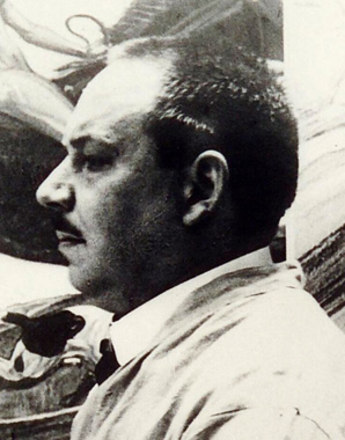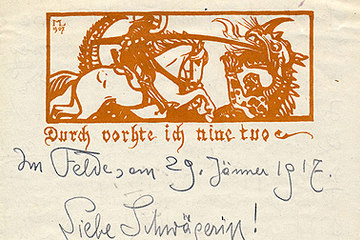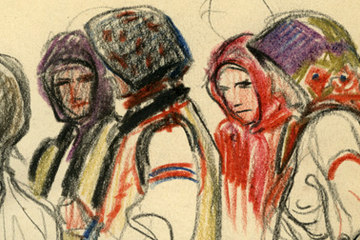Maximilian Liebenwein
- Officer and artist
Maximilian Liebenwein was born in Vienna on 11 April 1869. After his schooldays at the Vienna Schottengymnasium he studied painting at the Academy of Art with Julius Victor Berger and Matthias von Trenkwald. He left the Academy in 1893 and moved to Karlsruhe where he studied with Kaspar Ritter and Heinrich Zügel. Together with Heinrich Zügel he then moved to Munich to the Academy of Art, where he remained until 1897. After studying with Zügel Maximilian Liebenwein worked in Munich as a freelance painter before moving to Burghausen in 1899. Here he lived on the ground floor of the Forstmeister Tower – the largest tower of the exterior castle complex.
Maximilian Liebenwein’s versatile oeuvre is aligned between Impressionism and Art Nouveau and as well as painting includes drawings, illustrations, ex libris, and furniture design. The years between 1897 and 1900 brought the artist his first major successes. Exhibitions followed in Salzburg, Linz and Munich. In 1900 his pictures “Parzival” and “Animal Studies” were presented in the gallery of international masters in the spring exhibition of the Vienna Secession. In the same year Maximilian Liebenwein became a member of the Vienna Secession and furthermore its vice-president in 1912.
On 28 April 1901 he married Anny Essigmann, who likewise moved to Burghausen. Two children were born to them (Hans Georg and Wolfgang Ferdinand). The family moved to Linz in 1907 and eventually to Vienna in 1909. The Liebenweins’ marriage did not last long, however; Maximilian’s wife Anny died of breast cancer on 12 July 1915, which is why her elder sister Clementine Essigmann took over the children’s upbringing. During his years in Vienna he played a great part in the First International Hunting Exhibition in 1910, in which he presented his monumental paintings.
After the First World War broke out, Maximilian Liebenwein volunteered for duty but was at first rejected because of his advanced age – he was 45 years old at the time – which greatly disappointed him. On 3 June 1915, only five weeks before his wife’s death, he was at last mobilised. He was recruited as territorial first lieutenant to the XVII Corps Command and performed active duty as commander of the cavalry squadron, also as orderly officer and adjutant of the General.
His grandfather Josef Kundrat had been hunting officer and valet to Emperor Franz Joseph, thus Liebenwein already had close contacts to the Imperial House. For this reason he received the personal authorisation of the emperor to continue painting during his military service and to choose his motifs freely. He was not an official war painter, hence he could only devote himself to painting when there was no military action. He thus documented his diverse impressions from everyday life at the front, composed landscape studies, portrayed the population, drew soldiers and many of the horses under his care. He produced 54 sketchbooks during the war, creating a visual war diary.
His command was stationed at first on the Eastern Front, where he experienced heavy military action. He was moved to various fronts in Poland, Volhynia (Ukraine) and Tyrol. After three Isonzo battles he was promoted to cavalry captain in summer 1918. At the end of the war he finally returned from the Eastern Front to Vienna on 6 December 1918 in a journey home via East Prussia that took him one month.
After the war Maximilian Liebenwein spent another three years in Vienna before moving back to Burghausen in 1921. His cycle of twelve pictures on the Life of the Virgin Mary which he worked on between 1919 and 1925, afforded him his last great success. On 17 July 1926 Maximilian Liebenwein died in the Munich Hospital from the effects of a cerebral stroke.







